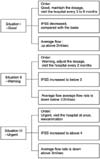Abstract
Purpose
As our society ages, a disease like benign prostatic hyperplasia (BPH) are increasing and needs consequent management. Recently, through the expansion of the communication infrastructure and terminals, a network services can be provided. However, the concern about distant medical management is increasing. We introduce here the Personal BPH Control Program (PBCP) and its application to clinical patients.
Materials and Methods
We have asked BPH patients to input the variable elements on the digital survey through the Personal Digital Assistant (PDA) once a week. We used the International Prostate Symptom Score (IPSS) and the average flow rate as the variable elements. We have used an algorithm to determine the patients condition. With this, we have developed a program that helps patients to adjust their visits to the hospital.
Results
According to the input elements, we have determined that the patients' condition was good (visit the hospital every 3 months) when the IPSS decreased, compared with the baseline and when the average flow rate was up above 2ml/sec. The patients' condition was a warning (visit the hospital every 2 months) when the IPSS was increased to below 3 and the average flow rate was down below ±2ml/sec, and the patients' condition was urgent when the IPSS increased to above 4 and the average flow rate was down above 3ml/sec.
Conclusions
We expect that the PBCP has great socioeconomic utility when applying it to patients. A portable personal apparatus for measuring the flow rate is now being developed. When sufficient examples of applying the symptom algorithm have accumulated, we are going to report afterward the prospects of using the PBCP in the future.
Figures and Tables
References
1. Collins GN, Lee RJ, McKelvie GB, Rogers AC, Hehir M. Relationship between prostate specific antigen, prostate volume and age in the benign prostate. Br J Urol. 1993. 71:445–450.
2. Garraway WM, Collins GN, Lee RJ. High prevalence of benign prostate hypertrophy in the community. Lancet. 1991. 338:469–471.
3. Glynn RJ, Campion EW, Bouchard GR, Silbert JE. The development of benign prostatic hyperplasia among volunteers in the Normatic Aging Study. Am J Epidemiol. 1985. 121:78–90.
4. Korea National Statistical Office. Statistics of population/the aged. 2000.
5. Chung TG, Chung JS, Lee MS, Ahn HJ. Prevalence of benign prostatic hyperplasia in Jeong-Eup area: community-based study. Korean J Urol. 1990. 40:52–58.
6. Barry MJ, Fowler FJ Jr, O'Leary MP, Bruskewitz RC, Holtgrewe HL, Mebust WK, et al. The American Urologic Association symptom index for benign prostatic hyperplasia. J Urol. 1992. 148:1549–1557.
7. Hald T. Urodynamics in benign prostatic hyperplasia: a survey. Prostate. 1989. 2:69–77.
8. Gee WF, Holtgrewe HL, Albersten PC, Litwin MS, Manyak MJ, O'Leary MP, et al. Practice trends in the diagnosis and management of benign prostatic hyperplasia in the United States. J Urol. 1995. 154:205–206.
9. Mebust WK, Ackerman R, Barry MJ, Batista J, Bosch R, Boyle P, et al. Cocket ATK, Khoury S, Aso Y, Chatelaine C, Denis L, Griffiths K, editors. Symptom evaluation, quality of life and sexuality. Proceedings of the 2nd International Consultation on BPH. 1993. Paris: SCI;131–143.
10. Schäfer W, Rübin H, Noppeney R, Deutz FZ. Obstructed and nonobstructed prostatic obstruction: aplea for urodynamic objectivism of bladder outflow obstruction in benign prostatic hyperplasia. World J Urol. 1989. 6:198–203.
11. Hald T. Urodynamics in benign prostatic hyperplasia: a survey. Prostate. 1989. 2:Suppl. 69–77.
12. Denis L, Griffiths K, Khoury S, Cockett ATK, McConnell J, Chatelain C, editors. Proceedings of the 4th International Consultation on Benign Prostatic Hyperplasia (BPH). 1997. July 25, 1997; Paris. Jersey: Scientific Communications.




 PDF
PDF ePub
ePub Citation
Citation Print
Print





 XML Download
XML Download